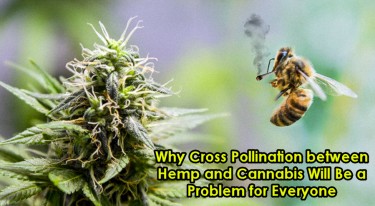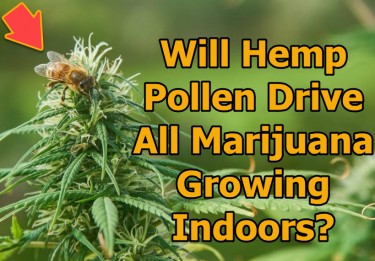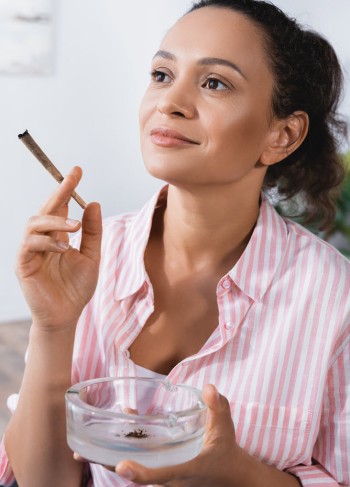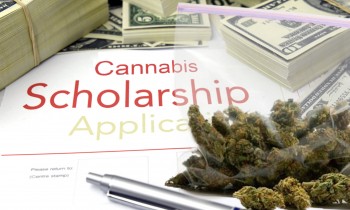How To Tell If Your Female Cannabis Plant Has Been Pollinated

New, novice or inexperienced cannabis cultivators sometimes cannot tell whether or not a female cannabis plant has been pollinated. Some can also not differentiate between the male plants and the female plants. This puts the entire operation at a risk.
Trust me, no one wants to smoke or consume pollinated cannabis. No farmer would even want to have pollinated crops unless he is perhaps a breeder. Pollination in cannabis crops leads to a significant decrease in the quality of the harvest. Meaning that the farmer would be selling at a lower rate than he should have.
Pollination of Cannabis Crops
One thing that can single-handedly change the quality of harvested cannabis is whether or not it has been pollinated (intentionally or not intentionally) to induce seed production.
Pollination of cannabis plants occurs once male pollen is available. In hermies, it occurs once the male reproductive organs begin to produce pollen.
For this reason, it is important as a cannabis farmer to be able to identify the indications that show that your female cannabis plants have been pollinated.
Female cannabis plants are mostly favored over their male counterparts, as they have been found to produce outputs with higher cannabinoid content and overall higher quality. When these female plants are pollinated, they begin to produce seeds, rather than quality buds. Yes!- a cannabis farmer is after the quality buds. By spending less energy on the production of these buds, the crops are set to produce a poor harvest.
Identifying pollinated female cannabis plants
The early indicators that show when a female plant has been pollinated include
-
Larger Bracts: A bract is a leaf-life structure that is usually small in size. They act as a shield for the female reproductive parts. This is the same point where buds develop during the flowering phase. When male pollen gets into the reproductive organs, the bracts become larger.
A harmless way to test if your plants' bracts are still in their normal states is to cut a bract using tweezers. Once removed, it has to be opened up. If the bract has a seed within, the plant has been pollinated.
-
Darker Pistil hairs: Before pollination, the pistil hairs are usually white. Once pollination occurs, they dry up and take up a darker appearance.
-
White Pistil Stalks: In pollinated female plants, the pistils stalks maintain their white color, while the tips of the hair-like structures turn darker. Pistil stalks in unpollinated plants also change in color, however, the change can be observed from the stalk to the tip of the structures.
Preventing cannabis pollination
The first aspect to understand when trying to prevent pollination in female cannabis plants is that Pollination occurs due to male pollen.
The best and efficient way to avoid pollination is for growers to keep the male plants and intersex plants away from the female plants. This will prevent direct pollination.
There will also be males and hermies who managed to evade the farmer up until the flowering stage.
This is why the farmer has to be observant from the beginning of the operation till the end. Male plants release their pollen within the first three weeks of flowering, hence the farmer has to take total care to frequently check for these unwanted plants. Once they are spotted, the farmer must uproot them immediately.
However, indirect or intentional pollination can occur when the male pollen is carried over long distances by physical elements, such as water, wind, or even other animals like birds and rodents, to where female cannabis plants are situated. The microscopic nature of male pollen makes it easier for it to travel over 3 miles in good weather conditions, and 30 miles in rough weather conditions. In this case, frequent checkups will help the farmer do away with crops that are showing signs of pollination.
Identifying Male Cannabis Plants
The sex of cannabis plants can hardly be determined before the vegetative or flowering stage. Female plants show at later periods than the males. The farmer has to wait until the point when female plants begin to grow their pistils before they can be certain of the plant's sex.
Female plants develop wispy white hairs at the nodes between the stalk and the stem, while the male plants grow pollen sacs. These sacs appear as little balls which grow alone or in groups. At the peak of the pre-flowering stage, the pollen sacs burst open to spill the pollen within and thus, pollinate the females.
Not only outdoor female plants can become pollinated
Novice growers get surprised when their indoor cultivated female plants begin to show signs of pollination. Different factors can cause this phenomenon.
Indoor cultivation on its own is playing safe, but it isn't 100% harm-proof against male pollen. In these cases, the first major suspect pollination agent would be the grower. They may have unknowingly brought in the microscopic pollens into the growing area.
Stress in female plants can also induce the development of pollen sacs in the nodes. This stress could be a result of unfavorable environmental factors such as light leaks. These new structures, called bananas, are often hard to detect, as they occur directly on the female buds. While growers may find it easy to discern between male and female organs in hermaphrodite plants, it is not so easy in stressed plants.
How to salvage the situation
For growers that do not detect pollination until it is too late, the suitable way to make the best of the disheartening situation would be to plant the resulting seeds. If the seeds are produced from a high-quality crop, the farmer can consider selling to other growers looking to grow genetically stable and consistent cannabis plants.
It is important to state that this could go in two ways, in the event of indirect or accidental pollination, the farmer risks having a crop with poor productivity, and less than acceptable standard.
For self-pollinated crops, it is best to dispose of them because their hermaphroditic traits will be transferred once again to the offspring.
Last Hit
When detected early, pollinated female plants and the male plants must be gotten rid of to save time and other resources.
HEMP AND CANNABIS POLLINATION ISSUES, READ MORE...
WHY HEMP AND CANNABIS CROSS POLLINATION IS A BIG PROBLEM!








